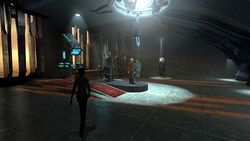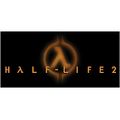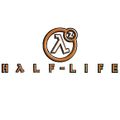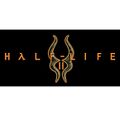Half-Life 2
| Warning! This article has yet to be cleaned up to a higher standard of quality, per our Cleanup Project. It may contain factual errors and nonsense, as well as spelling, grammar and structure issues, or simply structure problems. Reader's discretion is advised until fixing is done. | ||
|---|---|---|
You can help clean up this page by correcting spelling and grammar, removing factual errors and rewriting sections to ensure they are clear and concise, and moving some elements when appropriate. |
This article is outdated. You can help by updating it to reflect recent events or newly available information. |
|---|
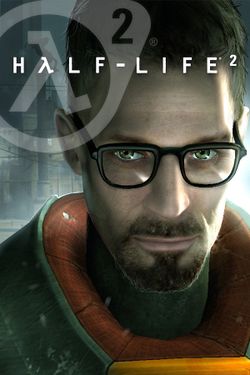
| |
| Half-Life 2 | |
|---|---|
| Developer(s) | |
| Release date(s) |
November 16, 2004 |
| Genre(s) | |
| Mode(s) | |
| Platform(s) |
Windows, Xbox, Xbox 360, PlayStation 3, macOS, Linux, Shield |
| Rating(s) |
ESRB: M (Mature) |
| Distribution | |
| System req |
1.7 GHz processor, 256 MB RAM, DirectX 8.1 level graphics card, Internet connection, Keyboard and mouse, Xbox 360 Controller, Sixaxis Controller, DualShock 3 Controller |
| Engine | |
| Series | |
| Writer(s) | |
| Composer(s) | |
| Previous game | |
| Next game | |
- "So, wake up, Mr. Freeman. Wake up and smell the ashes."
- ― The G-Man
Half-Life 2 is a science fiction first-person shooter developed by Valve Corporation, and the sequel to the acclaimed Half-Life. It was released on November 16, 2004,[1] following an extended development period of five years. The game garnered near unanimous positive reviews and received critical acclaim, winning over 35 Game of the Year awards for 2005. It is included in The Orange Box for PlayStation 3, Xbox 360, and PC.
The game uses the Source engine, which includes a heavily modified version of the Havok physics engine.
Contents
Plot[edit]
Taking place in and around City 17 about twenty years after the events of Half-Life,[2] Half-Life 2 follows the scientist Gordon Freeman. Gordon is thrust into an unfamiliar environment by the mysterious G-Man, in which the aftermath of the Black Mesa Incident has come to bear fully upon human society. Freeman is forced to battle against increasingly unfavorable odds in order to free Mankind from interdimensional invaders known as the Combine. In his struggle, he is joined by various allies, including fellow scientists, rebels, friends (such as Alyx Vance), and even Vortigaunts, all of whom are surprised to see him alive. After fighting through City 17 Gordon makes his way to The Citadel where he destroys it. Pausing the blast of the building, The G-Man tells Gordon about other interesting offers of employment.
Characters[edit]
Enemies[edit]
Weapons[edit]
Development[edit]
The book Half-Life 2: Raising the Bar,[3] and, against the developer's will, the 2003 leak and its numerous files, revealed many of the game's original settings and actions that were cut down or removed entirely from the final game. Half-Life 2 was originally intended to be a far darker game with far grittier artwork where the Combine were more obviously draining the oceans for minerals and replacing the atmosphere with noxious, murky gases.
Half-Life 2 was also originally intended to be much more diverse in settings. Several City 17 levels at the start of the game and complete chapters from the second half of the game were completely removed and sometimes re-introduced in the subsequent Half-Life 2 Episodes, as well carry on in its main following up prequel, Half-Life: Alyx.
Gameplay[edit]
Half-Life 2 plays similarly to its predecessor. The player navigates through a linear set of levels, fighting off transhuman troops known as the Combine as well as hostile alien creatures. Puzzles and sequences involving vehicles are interspersed throughout the game, breaking up stretches of on-foot combat and exploration.
Since Half-Life 2 is a first-person shooter, the gameworld is always presented from Gordon Freeman's perspective, and the player is implicitly asked to place themselves in Gordon's shoes. A heads-up display at the bottom of the screen shows the player's health, energy, and ammunition status, while a toggle screen shows available weapons at the top. Health and energy can be replenished by picking up medical supplies and energy cells respectively, or by using wall-mounted health stations and charging devices, respectively.
The HEV Suit is a staple of Half-Life, making another appearance as the Mark V iteration, upgraded from the Mark IV version from the original Half-Life. The suit holds up to 100 Energy, which is depleted from damage, usually gunfire. The suit is recharged either by energy cells, or charging devices, found throughout the game.
The player defeats enemies with an assortment of weapons. The game's available arsenal consists largely of modern-day weapons, primarily pistols and shotguns, though more elaborate weapons are available, such as a crossbow that shoots hot metal rods, and pheromone pods that summon and direct Antlions. The Source engine's physics capabilities extend into combat via a special device called the Zero Point Energy Field Manipulator, or Gravity Gun. Using this device, the player can pick up objects and either launch them at enemies or hold them in place to create a makeshift shield. The Gravity Gun can also perform a variety of non-combat functions, such as grabbing out-of-reach supplies, forming bridges across gaps, and flipping overturned vehicles.
Many puzzles use the game's physics engine. For example, one puzzle requires the player to either turn a seesaw-like lever into a ramp by placing cinder blocks at one end, or to stack wooden crates to form a crude stairway. Puzzles are frequently solved with the Gravity Gun. One such puzzle has the player clear a highway by using the gravity gun to push numerous abandoned vehicles out of the way.
Reception[edit]
Half-Life 2's public reception was overwhelmingly positive in terms of reviews, acclaim, and sales. It was critically acclaimed for advances in computer animation, sound, narration, computer graphics, artificial intelligence (AI) and physics. As of December 2008, 6.5 million copies of the game had been sold through retail.[4] The Steam sales have not been revealed, but they may be around 8.3 million including retail and Steam.[5] The sales for Half-Life 2 have been relatively steady since its release. If Half-Life 2 eventually surpasses Half-Life in sales, it will take the title of the best-selling first-person shooter game to date.
Roughly 25 percent of all Half-Life 2 copies have been purchased using the Steam content delivery service; their exact number is between 750,000 and one million, depending on whether they are included in the figure of 6.5 million.[6] Overall, the Half-Life franchise, including Counter-Strike and Day of Defeat, has seen over 20 million sales.[7]
Critical response[edit]
Half-Life 2 became and remains one of the most highly acclaimed video games in history. At least 35 Game of the Year awards were given to Half-Life 2, and most major game reviewers gave ratings within the 90-100% range. Half-Life 2 holds Metacritic's highest ranking and standing ("universal acclaim") among PC games with a score of 96, followed directly by Half-Life (also with a score of 96). Maximum PC awarded Half-Life 2 an unprecedented 11 on their rating scale which peaks at 10, and named it the "best game ever made."
Individual reviews were almost universally glowing. Sources such as GameSpy, The Cincinnati Enquirer, and The New York Times have given perfect reviewing scores, and others such as PC Gamer and IGN gave near-perfect scores (it was one of only four games ever to get 96% from UK PC Gamer, the best score they have ever awarded, and the game is only one of two games ever to get a near perfect score, 98%, from PC Gamer), while the game became the fifth title to receive Edge magazine's ten-out-of-ten score. Critics who applauded the game cited the game's advanced graphics and physics along with the relatively low system requirements, atmosphere, storytelling, and characterization.[8][9]
Very few reviewers gave Half-Life 2 lower than a nine out of ten rating. One such critic was Netjak, a reviewing website known for its relative harshness, which gave Half-Life 2 a rating of 8.5. Several critics, including some that had given glowing reviews, complained about the required usage of Steam along with a difficult installation process.
Awards[edit]
Half-Life 2 earned over 35 Game of the Year awards, including Overall Game of the Year at IGN, GameSpot's Award for Best Shooter, GameSpot's Reader's Choice - PC Game of the Year Award, Game of the Year from The Academy of Interactive Arts & Sciences, and "Best Game" with the Game Developers Choice Awards, where it was also given various awards for technology, characters, and writing. The game also had a strong showing at the 2004 BAFTA Games Awards, picking up 6 awards, more than any other game that night, with awards including "Best Game" and "Best Online Game."[10]
World records[edit]
Guinness World Records awarded Half-Life 2 the world record for the "Highest Rated Shooter by PC Gamer Magazine" in the Guinness World Records: Gamer's Edition 2008. Other records awarded to the game in the book include, "First Game to Feature a Gravity Gun" and "First PC Game to Feature Developer Commentary".
Products[edit]
The popularity of Half-Life 2 and the Half-Life series has led way to an array of side products and collectibles. Valve offered Half-Life-related products such as plush Headcrabs, posters, clothing, and mousepads on its official store.[11]
Technical[edit]
Source engine[edit]
For Half-Life 2, Valve developed a new game engine called the Source engine, which handles the game's visual, audio, and artificial intelligence elements. The Source engine comes packaged with a heavily modified version of the Havok physics engine that allows for an extra dimension of interactivity in both single player and online environments.
Additionally, when coupled with Steam, the engine can be easily upgraded to include many new graphical technologies. One such example is high dynamic range lighting, which Valve debuted as a free level called Half-Life 2: Lost Coast, which functions as a playable tech demo for the new technology.
Steam content delivery system[edit]
Integral to Half-Life 2 is the Steam content delivery system developed by Valve Software. All Half-Life 2 players are required to have Steam installed and a valid account in order to play. Steam allows customers to purchase games and other software straight from the developer and have it downloaded directly to their computer as well as receiving "micro updates." These updates also make hacking the game harder to do and has thus far been somewhat successful in staving off cheats and playability for users with unauthorized copies. Steam can also be used for finding and playing multiplayer games through an integrated server browser and friends list, and game data can be backed up with a standard CD or DVD burner. Steam and a customer's purchased content can be downloaded onto any computer, as long as that account is only logged in at one location at a time.
The usage of Steam has not gone without controversy. Some users have reported numerous problems with Steam, sometimes being serious enough to prevent a reviewer from recommending a given title available on the service. In other cases, review scores have been lowered. Long download times, seemingly unnecessary updates, and verification checks are criticisms leveled by critics of the system's use for single player games such as Half-Life 2. Whether or not a customer intends to use any multiplayer features, the computer the game was installed on must have Steam and an Internet connection to verify the transaction.
Release and distribution[edit]
A 1GB portion of Half-Life 2 became available for pre-load through Steam on August 26, 2004. This allowed customers to begin downloading encrypted game files to their computers before the official release of the game. When the game's release date arrived, customers were able to purchase the game through Steam, unlock the files on their hard drives, and play the game immediately, without having to wait for the entire game to download. The pre-load period lasted for several weeks, with additional portions of the game being made available progressively, ensuring that all customers had the opportunity to download the content before the game's official release.
Half-Life 2 was simultaneously released through Steam, CD (most initial U.S. "bare-bones" retail copies), and on DVD in several editions. Through Steam, Half-Life 2 was available in three packages that customers could purchase. The basic version ("Bronze") includes only Half-Life 2 and Counter-Strike: Source, while the "Silver" and "Gold" (collector's edition) versions also include Half-Life: Source and Day of Defeat: Source (ports of the original Half-Life and Day of Defeat mod to the new engine), as well as the ability to download all previous Valve games through Steam. The collector's edition/Gold version additionally includes merchandise such as a t-shirt, a strategy guide, and a CD containing the soundtrack from Half-Life 2. Both the disc and Steam versions require Steam to be installed and active for play.
Subsequent releases[edit]
A demo version with the file size of a single-CD was later made available in December 2004 at the website of graphics card manufacturer ATI Technologies, who teamed up with Valve for the game. The demo contains part of the opening level of the game, and also part of the chapter "We Don't Go To Ravenholm...". In September 2005, Electronic Arts distributed the Game of the Year edition of Half-Life 2. Compared to the original CD-release of Half-Life 2, the GOTY edition adds Half-Life: Source.
On December 22, 2005, Valve released a 64-bit version of the Source engine that takes advantage of AMD64 processor based systems running 64-bit version of Windows operating system. This update, delivered via Steam, enabled Half-Life 2 and other Source-based games to run natively on AMD64 processors, bypassing the 32-bit emulator. Gabe Newell, one of the founders of Valve, stated that this is "an important step in the evolution of our game content and tools," and that the game benefits greatly from the update.[12] The response to the release varied: some users reported huge performance boosts, while technology site Techgage found several stability issues and no notable frame rate improvement.[13] 64-bit users have widely reported bizarre in-game errors including characters dropping dead, game script files not being pre-cached (i.e., loaded when first requested instead), map rules being bent by AI, and other glitches.
Ports[edit]
An Xbox port published by Electronic Arts was released on November 15, 2005. While subject to positive reception, critics cited its lack of multiplayer and frame-rate issues as problems, and the game received lower scores than its PC counterpart.
During Electronic Arts' summer press event on July 13, 2006, Gabe Newell announced that Half-Life 2 will ship on next-generation consoles (specifically, the PlayStation 3 and Xbox 360) including Episodes One and Two, Team Fortress 2, and Portal. This five game package would later be known as The Orange Box and was shipped to PC and Xbox 360 on October 10, 2007. The PlayStation 3 version was delayed and finally shipped on December 11, 2007. There were reports Valve was having troubles with the PlayStation 3 hardware and it shows with bouts of slowdown that are not seen on the Xbox 360 or PC versions.
Expansions[edit]
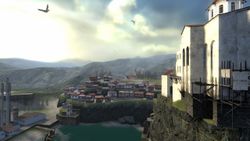
Since the release of Half-Life 2, Valve has released an additional level and two additional expansion sequels. The level, Lost Coast, takes place between the chapters Highway 17 and Sandtraps and is primarily a showcase for high dynamic range imaging (HDR) technology.
Sequels[edit]
|
The sequels Half-Life 2: Episode One and Half-Life 2: Episode Two take place shortly after the events of Half-Life 2, with the player once again taking on the role of Gordon Freeman and with Alyx Vance playing a more prominent role and expanding the mysteries surrounding the G-Man and the Vortigaunts. Additionally, one further episode was set to be released in the future, dubbed Episode Three; being the last expansion, "in a trilogy".[14] In an interview with Eurogamer, Gabe Newell informally referred to the Half-Life 2 Episodes as Half-Life 3 for short.[15] He reasons that rather than force fans to wait another six years for a full sequel, Valve would release the game in episodic installments.[15] Newell admits that a more correct title for these Episodes should have been "Half-Life 3: Episode One" and so forth, having referred to the Episodes as Half-Life 3 repeatedly through the interview.
It was confirmed in April 2006 that Half-Life 2: Episode Four was in production, and that it would mark the start of a new story arc. Furthermore, it was confirmed that Episode Four was under development by a third-party studio under Valve Corporation's supervision.[16]
In March 2020, the story arc of Half-Life 2 and its Episodes received a prequel set five years earlier, Half-Life: Alyx.
Mods[edit]
Since the release of the Source engine SDK, a large number of mods have been developed by the Half-Life 2 community. Mods vary in scale, from fan-created levels and weapons, to partial conversions such as Half-Life 2 Substance and Smod (which modify the storyline and gameplay of the pre-existing game), and Garry's Mod (which allow the player to experiment with the physics system in a sandbox mode), to total conversions such as Dystopia or Empires, which transforms the game from a first-person shooter into a real-time strategy game. Some mods take place in the Half-Life and Portal universe; others in completely original settings; while some are tributes to other games, such as GoldenEye: Source, a recreation of GoldenEye 007, or Resident Evil: Twilight, based on the Resident Evil series.
Soundtrack[edit]
Gallery[edit]
Steam[edit]
Badges[edit]
Emoticons[edit]
Cover art[edit]
Logos[edit]
Early logo concept by Vivendi.
Logo designs for Sierra games, among them an early Half-Life 2 concept.
Promotional[edit]
Official Half-Life 2 skin for Windows Media Player 9 Series released in 2003.
Other[edit]
References[edit]
- ↑ Half-Life 2 on Steam
- ↑ Half-Life 2: Episode One official website
- ↑ Half-Life 2: Raising the Bar
- ↑ Valve Reveals Lifetime Retail Sales of Half-Life, Counter-Strike Series on Shacknews
- ↑ Analysis: Valve's Lifetime Retail Sales For Half-Life, Counter-Strike Franchises on Gamasutra (December 3, 2008)
- ↑ Steam's Finances on SteamReview.org (October 26th, 2005)
- ↑ First in Half-Life Episodic Trilogy Debuts at Number 1 on Steam (June 8, 2006) (archived)
- ↑ Half-Life 2 IGN Review
- ↑ Half-Life 2 Action Button Review
- ↑ Awards on ValveSoftware.com (archived)
- ↑ The Valve Store (archived)
- ↑ Valve Unveils 64-bit Source(TM) Gaming Technology Developed In Conjunction With AMD on Steam (December 22, 2005) (archived)
- ↑ Review: Half-Life 2: 64-Bit - Reason to get excited? on Techgage (December 26, 2005) (archived)
- ↑ Half-Life 2: Episode One gold, Two dated, Three announced on GameSpot (May 24, 2006) (archived)
- ↑ 15.0 15.1 Interview - Opening the Valve. Eurogamer. Retrieved on June 7, 2006.
- ↑ Episode 4: stand alone plot on the ValveTime Forums (April 3, 2006)
